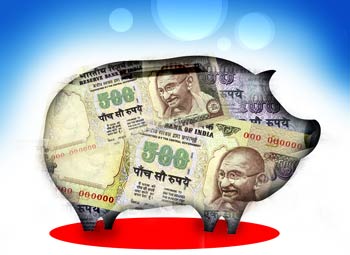 ave! Save! Save!
ave! Save! Save!
That is what every financial planner (not to mention every family member) will tell you the day you start earning.
But the more critical issue that is rarely addressed, is how much one must save.
Let's try to figure it out.
 It's not about sacrifice
It's not about sacrifice
People normally associate saving with miserly behavior.
But, just because you want to save does not mean you have to stop having fun.
Saving does not automatically translate into having to drastically curb your social life and cramp your lifestyle.
In fact, the more you sacrifice, the more difficult it is to save.
All it requires is a balance.
Trust me, you will emerge a winner later.
So how do you begin?
It is actually very simple.
Look at what you earn. And then look at where you would like your money to be spent.
Let's say you are 23 and have landed your first job. Let's further assume you are living with your parents and earning Rs 12,000 every month.
All your spending will broadly fall under the following categories.
Now break it up into normal expenditure and lavish living.
For instance, it could look like this.
|
|
Normal |
Exorbitant |
|
Contribution at home |
0 |
- |
|
Shopping |
2,000 |
4,000 |
|
Travel |
1,500 |
2,500 |
|
Entertainment |
4,000 |
5,000 |
|
Loan repayments |
0 |
- |
|
Essentials |
1,000 |
|
|
Your savings |
3,500 |
Rs 500 |
In the above example, your expenses amount to Rs 8,500. But, if you were to live lavishly, they would shoot up to Rs 11,500.
So now you can clearly see where your money is going and what limits you must place on it.
1. Learn to adjust
Don't be absolutely rigid. If you find that you spend more on travel and shopping, then maybe you could cut down on entertainment.
Or, if in one month, you have gone beserk by frequenting every single sale in town, then you can survive by curbing your spending in the other categories.
2. Be imaginative
If you find your travel bills mounting, try compromising.
On and off, deliberately bypass the taxi or autorickshaw and hop onto a bus or the train.
Try and take lifts from your family or a neighbour (even if it means reaching early).
Form a travel groups or maybe a car pool among your co-workers.
If you wardrobe desperately needs new clothes, look for sales or frequent factory outlets for branded clothes.
If you find that a bulk of your shopping is on branded outfits, cut it down. Ensure that you have one branded piece of clothing and the rest can be cheaper options to go with it. For instance, a pair of branded jeans will go well with a cheaper shirt or kurta.
Find yourself eating out often? Ensure that don't order dessert and cut down on alcohol. This will benefit your health and wallet. When you go for a movie, avoid snacking inside the theatre (everything is exorbitantly priced).
Look for ways in which you can curb your spending without making you feel miserable.
3. Plan future expenses
If you don't have a loan right away, but want to opt for one, you will be able to easily figure out how big a loan you can afford.
Once you list your earnings and expenditure, you are in a position to take a clear call on your finances.
Of course, you will have to decide where your expenses will have to be cut to service this loan. If you stretch it over a number of years, you will be able to comfortably manage the monthly payments as you can expect a salary hike every year.
4. Calculate it over a year
This will give you a better perspective. For example, if you spend Rs 5,000 every month on entertainment, that would be Rs 60,000 per annum. A fairly large amount of money to be "blown up".
5. Take a percentage
Just because your friend spends Rs 5,000 a month on entertainment, does not mean it is the right amount for you.
Your friend may be earning Rs 20,000 a month. In that case, it would amount to 25% of his salary.
But, if you spend the same amount, it would amount to a phenomenal 41% of your salary (Rs 12,000) being spent. View all your expenses with reference to the amount you are earning.
6. Put savings as a category
Add another category to the above table and call it savings. In this way, you will begin to view savings as a forced expenditure. In fact, put it as the first category.
So when you set aside money for your contribution towards your home, loan payments and essentials, put a little amount aside as savings.
The balance can then be divided amongst the rest of the categories like travel, shopping and entertainment.
In this way, no matter how big a spendthrift you are, some money is automatically saved every month.
A good option would be to consider a recurring deposit. You can do it with the bank or the post office. If it is with the bank, you can instruct them to directly debit it from you account.
Or, if you want to be a little more adventurous with your money, you can try a Systematic Investment Plan with a mutual fund.
No one is saying that you have to start saving 50% of your salary. All you have to do is begin by making saving a habit, however small the amount.
And yes, it always helps to be aware as to where your money is being spent.
Illustration: Dominic Xavier




